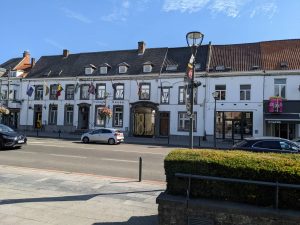
Waterloo 2022: Wellington Napoleon and Mont St Jean
Today’s tour started at the Wellington Museum which is housed in Wellington’s Headquarters in Waterloo itself. I’m going to digress from being a tour guide here now and mention the fact that having been round the various museums here, I am quite grateful that there is in fact a Wellington Museum at all.
I’ve seen various commentaries online about the huge local concentration here on Napoleon rather than the Allied commanders. People who complain about this are generally mocked for being Wellington groupies and undoubtedly in some cases that’s true, but it is striking, particularly in the various gift shops. I think it might have improved very slightly since I came four years ago in that it is now possible to buy one Wellington item in the main gift shop but that is completely overwhelmed by the vast amount of Napoleon memorabilia. Personally I don’t really need any more souvenirs but the difference is striking.
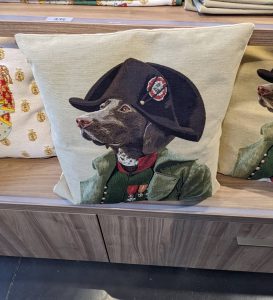 I have no idea whether there’s something political about this, whether it’s considered Napoleon was the most important person at Waterloo given that he was an Emperor or whether they just don’t think Wellington or Blucher memorabilia will sell. I do think it should probably be redressed, but if it’s a marketing decision then I guess that’s a good enough reason. All the same, Napoleon as a dog was a bit much for me.
I have no idea whether there’s something political about this, whether it’s considered Napoleon was the most important person at Waterloo given that he was an Emperor or whether they just don’t think Wellington or Blucher memorabilia will sell. I do think it should probably be redressed, but if it’s a marketing decision then I guess that’s a good enough reason. All the same, Napoleon as a dog was a bit much for me.

The Wellington museum is a poignant reminder of the human cost of battle. Wellington’s staff had done surprisingly well through the long years of the Peninsular War but his luck ran out at Waterloo. This was where Kristine’s knowledge of the people came into its own and the excerpts from Wellington’s letters were very emotional. During the years I’ve been writing the Peninsular War Saga, I’ve got to know some of these young men as if they were my own fictional characters and it was surprisingly painful to think of Alexander Gordon’s death and Fitzroy Somerset’s agonising operation to amputate his arm. There’s a lot of information about Wellington through the various sites, but in this house I found it much easier to imagine Wellington the man, struggling to write the early part of his Waterloo dispatch while receiving news of the death and wounding of his friends.
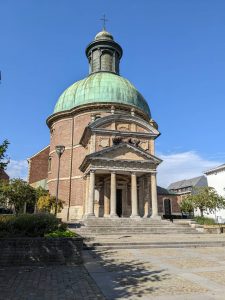 Across the busy road from the Wellington Museum is the elaborate church which was there at the time of the battle and used, like many churches, as a hospital to receive wounded men. Those of you who have followed me for a while know that I have a thing about old churches and this one was particularly peaceful, with a number of memorials to the men who fought and died during the Waterloo campaign. Memorials at this time tended to be paid for either by the family of the dead man or by subscription through the various battalions and regiments, so not surprisingly more of them relate to the wealthier regiments. Very few of the memorials even mention the NCOs and enlisted men apart from this one in the church, which may well be the first of its kind.
Across the busy road from the Wellington Museum is the elaborate church which was there at the time of the battle and used, like many churches, as a hospital to receive wounded men. Those of you who have followed me for a while know that I have a thing about old churches and this one was particularly peaceful, with a number of memorials to the men who fought and died during the Waterloo campaign. Memorials at this time tended to be paid for either by the family of the dead man or by subscription through the various battalions and regiments, so not surprisingly more of them relate to the wealthier regiments. Very few of the memorials even mention the NCOs and enlisted men apart from this one in the church, which may well be the first of its kind.

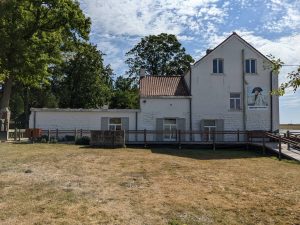 After lunch we moved on to Napoleon’s Headquarters in the farmhouse of Le Caillou, where Napoleon and his staff spent the night of June 17, 1815. The museum collection is spread over five rooms and tells the story of the Emperor’s actions in the hours before Waterloo. There are a number of artefacts relating to Napoleon, though Gareth queried whether some of the furniture was authentic given that the Prussians reputedly set fire to everything on their way through after Napoleon’s departure. Still, it gives a good sense of how the farm might have looked at the time.
After lunch we moved on to Napoleon’s Headquarters in the farmhouse of Le Caillou, where Napoleon and his staff spent the night of June 17, 1815. The museum collection is spread over five rooms and tells the story of the Emperor’s actions in the hours before Waterloo. There are a number of artefacts relating to Napoleon, though Gareth queried whether some of the furniture was authentic given that the Prussians reputedly set fire to everything on their way through after Napoleon’s departure. Still, it gives a good sense of how the farm might have looked at the time.
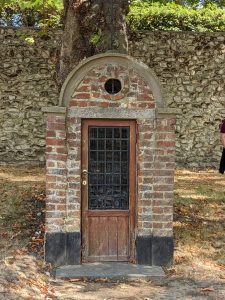 In the garden outside the farmhouse are one or two memorials. There is also an ossuary, which is a small building intended to serve as the final resting place of human bones. Ossuaries are often used where burial space is scarce but in this case it has become a depository for bones found on the battlefield over the years. I’ve seen photos of this but found the real thing unexpectedly moving.
In the garden outside the farmhouse are one or two memorials. There is also an ossuary, which is a small building intended to serve as the final resting place of human bones. Ossuaries are often used where burial space is scarce but in this case it has become a depository for bones found on the battlefield over the years. I’ve seen photos of this but found the real thing unexpectedly moving.
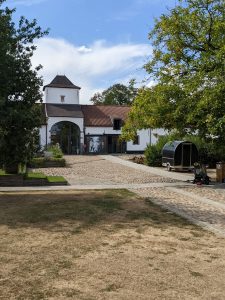
The final stop of the day was the medical museum, located at Mont Saint Jean, which was situated at the back of Wellington’s lines and became the main field hospital. We hit a slight problem here as it turned out the museum and attached bar had just moved over to winter opening hours and were closed. Fortunately Gareth’s local knowledge saved the day and after a short wait we were allowed to go in to the museum for a brief tour.
Mont Saint Jean is not for the faint hearted. The suffering of the wounded of both armies must have been indescribable, and Gareth read a distressing description of bloody bodies and severed limbs covering the ground outside the farm. There are vivid descriptions of the various wounds and operations performed and information about individual surgeons and their experience of the campaign.
There are also exhibits of medicine and surgical kits from the era and the uniforms worn by the medical staff. One or two models give an idea of the state of Mont Saint Jean as the wounded continued to pour in. I’ve always thought that the astonishing thing about surgery and medicine in the army at this time is how many of the operations actually succeeded and how many men survived their wounds. Survival would not have been improved by the invariable practice of bleeding a wounded man. It has sometimes occurred to me that once the initial operation was over, a shortage of surgeons might well have meant that a man would be bled less often which could improve his chances of survival…
After one of the shorter days with Waterloo 2022: Wellington Napoleon and Mont Saint Jean we went back to the hotel early for dinner and drinks, as we needed to get ready for the next day and our battlefield tour. For me this was going to be the highlight of the week and the main reason I came on this tour. This week has gone so quickly and I’ve learned so much, it’s been a joy. I should also mention that the group were fantastic and really good company.

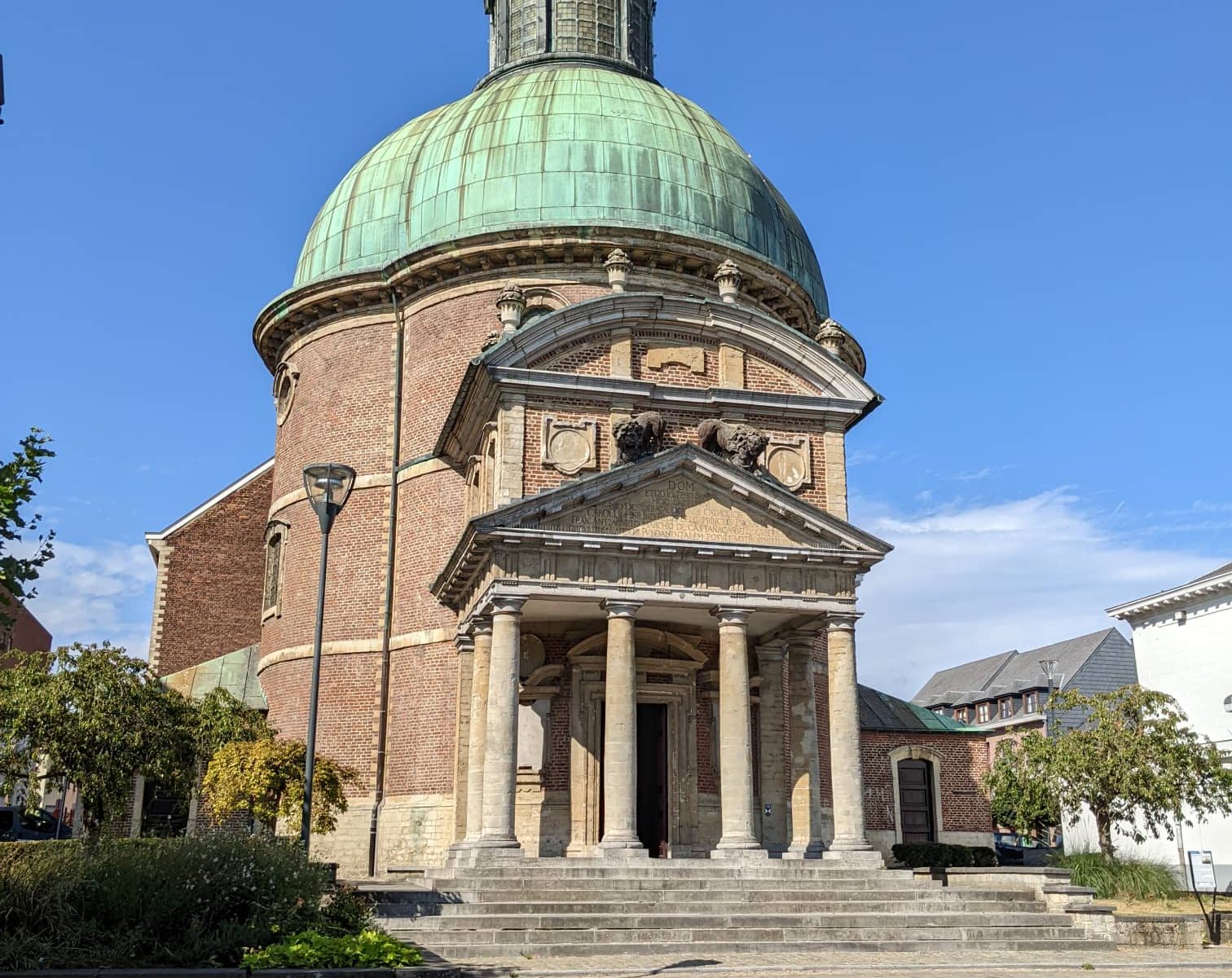
One of the interesting research lectures (at either Oxford or Cambridge) I read, several years ago was entitled ‘Why didn’t we learn the lessons from Waterloo? Surprisingly this was linking the medical survival rates in the Falklands and Waterloo. The speculation was that the weather conditions after the battles (men lying in the open in the cold and wet) actually allowed their systems to adjust andcope with shock and blood pressure hikes thus enabling them to face brutal surgery better. This was contrasted with the US Army’s Vietnam rush to get men into Casualty ASAP, with a higher mortality result.
That’s really fascinating, I’ll have a look for that.